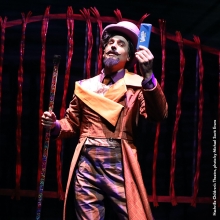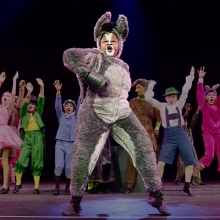Show History
History
Inspiration
New Girl in Town is based on Eugene O'Neill's play, Anna Christie, which made its Broadway debut at the Vanderbilt Theatre on November 2, 1921, and won the Pulitzer Prize for Drama in 1922.
As in many adaptations, the authors of New Girl in Town changed certain details when musicalizing the story. The musical ends on a much happier note than the original work.
New Girl in Town was created by Broadway veteran George Abbott and Broadway newcomer Bob Merrill as a star vehicle for Gwen Verdon, who had just finished playing the role of Lola in Damn Yankees, a Tony Award-winning performance.
Productions
New Girl in Town opened on May 14, 1957, at the Forty-sixth Street Theatre (now the Richard Rodgers) and closed on May 24, 1958, after 431 performances. The show was well received by both critics and audiences.
The Irish Repertory Theatre in New York City produced New Girl in Town in 2012. This production ran from July 18, through September 14, 2012, and featured Margaret Loesser Robinson, Cliff Bemis, Patrick Cummings and Danielle Ferland (who is best known for originating the role of Little Red in Into the Woods).
Cultural Influence
- New Girl in Town was so well received that much of the creative team came together a year later for yet another collaboration, Redhead.
- Composer/lyricist Bob Merrill was best known prior to his Broadway debut with New Girl in Town as the writer of the 1952 novelty tune, "(How Much Is) That Doggie in the Window?" popularized by Patti Page.
- RCA Victor first released the original cast recording of New Girl in Town in 1957.
- Both Carol Burnett and Martha Raye have recorded the song, "Flings," from the show.
Trivia
- Bob Fosse choreographed the original production of New Girl in Town, and was eager to showcase the talents of Gwen Verdon. He devised a second act dream sequence that depicted life in a brothel. Some audiences found the ballet sequence so scandalous that it actually drew gasps from the crowd, and during its tryout run in New Haven, Connecticut, local police closed the show. The sequence was cut from that production at George Abbott's request but was restored when the show moved to New York.
- Gwen Verdon's triumph as Anna in New Girl in Town helped to make the idea of a "triple threat" (an actor who can act, sing and dance) a standard by the end of the 1950s.
- The number, "Cathouse Ballet," was cut when the show tried out in Boston, possibly because it made Anna's former life as a prostitute appear far more appealing than her present circumstances. The producers went so far as to burn the scenery in the alley behind the theatre to prevent the sequence from being restored.
- According to musical theatre historians, the song, "Elegance," was written for New Girl in Town but not used. Dan Dietz writes in The Complete Book of 1950s Broadway Musicals that for years, rumors have persisted that the number was performed during the tryout, but programs for the New Haven and Boston engagements don't list it.




